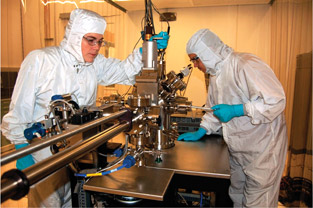
Nanoparticle Measurement
Two new standards developed by ASTM International Committee E56 on Nanotechnology will assist a variety of users in aspects of nanomaterial measurement.
E2834, Guide for Measurement of Particle Size Distribution of Nanomaterials in Suspension by Nanoparticle Tracking Analysis (NTA), and E2859, Guide for Size Measurement of Nanoparticles Using Atomic Force Microscopy, are both under the jurisdiction of Subcommittee E56.02 on Physical and Chemical Characterization.
E2834
E2834 describes nanoparticle tracking analysis, a new measurement technique for direct and real-time visualization and analysis of nanoparticles in liquids. In NTA, particles in suspension are illuminated with a focused laser beam, and light scattered from each particle is visible through magnifying optics fitted to a digital camera.
E2834 discusses the scientific basis for NTA as well as size limits, concentration ranges, sampling and sample preparation considerations, condition and analysis selection, data interpretation and comparison to other techniques.
Duncan Griffiths, an E56 member, says that, as a new technique, NTA has been deliberately kept simple and general to cover possible variants of the basic theory.
"Many of the details of the hardware and software involved are evolving rapidly, so there may be some extension or revision of the standard in the future," says Griffiths, who is the business development manager with NanoSight USA. "In the near term, test methods for specific sample types are expected to follow from this base document."
Griffiths notes that NTA is applicable to many nanomaterials, as well as a range of biotech and pharmaceutical samples, including drug delivery and virus and protein aggregates. The standard will be used primarily by industries regulated by the U.S. Food and Drug Administration and the U.S. Environmental Protection Agency as a means of referencing the basis of NTA.
E2859
According to Vince Hackley, Ph.D., research chemist and project leader in the Materials Measurement Science Division of the National Institute of Standards and Technology, E2859 provides guidelines for sample preparation, measurement and analysis of results related to the use of atomic force microscopy, or AFM. AFM is a technique used to image, measure and manipulate matter at the nanoscale. The guide describes the use of height measurements in order to determine the size of nanoparticles deposited on a flat substrate. AFM measurement has been adopted extensively within the nanotechnology community as an important tool for visualizing and quantifying structures on the nanoscale.
E2859 provides practical and metrological guidance for applying AFM to measure the size of substrate-supported nanoparticles, including:
- Procedures for dispersing nanoparticles on various surfaces in order for the particles to be suitable for imaging and height measurement via intermittent contact mode AFM;
- General AFM calibration and operation guidelines; and
- Procedures for data analysis and reporting.
"We believe this to be the first AFM-based international standard for particle size measurement on the nanoscale," says Hackley, an ASTM E56 member. "While the standard is a guide, it could potentially be converted into a test method in the future. E56.02 is interested in developing standards for nanoparticle characterization that have practical and immediate impact for the nanotechnology community."
E56 invites all interested parties from industry, regulatory agencies and others with an interest in the safe commercialization of nanotechnology to participate in the development of its standards.
To purchase ASTM standards, visit www.astm.org and search by the standard designation, or contact ASTM Sales (phone: 877-909-ASTM; sales@astm.org).
CONTACT Technical Information: (E2834) Duncan Griffiths, NanoSight USA • Costa Mesa, Calif. • Phone: 714-747-9955 | (E2859) Vincent A. Hackley, Ph.D, National Institute of Standards and Technology • Gaithersburg, Md. • Phone: 301-975-5790 | ASTM Staff: Kathleen McClung • Phone: 610-832-9717 | Upcoming Meeting: May 20-21 • May Committee Week • Indianapolis, Ind.
 SN Home
SN Home Archive
Archive Advertisers
Advertisers Masthead
Masthead RateCard
RateCard Subscribe
Subscribe Email Editor
Email Editor